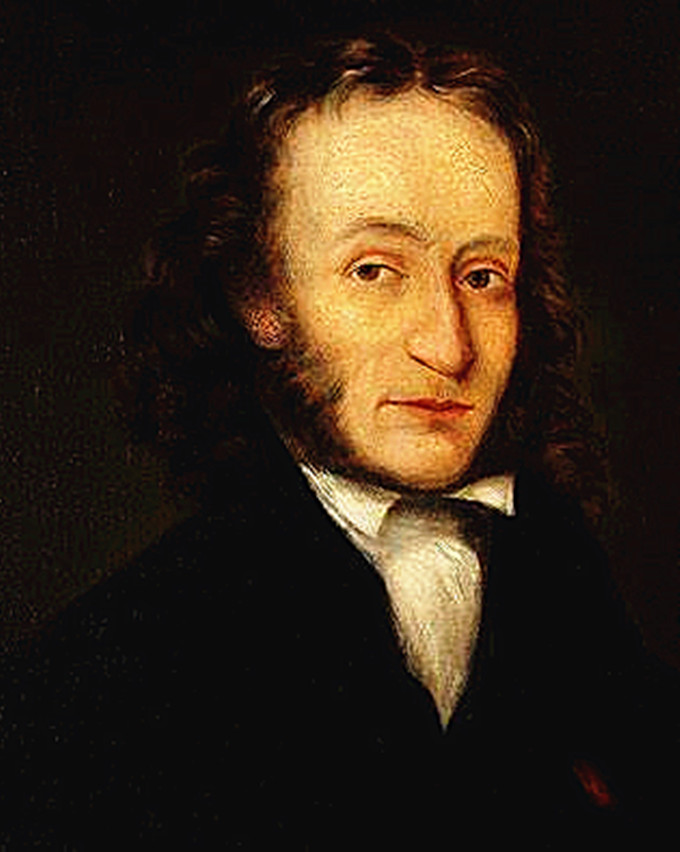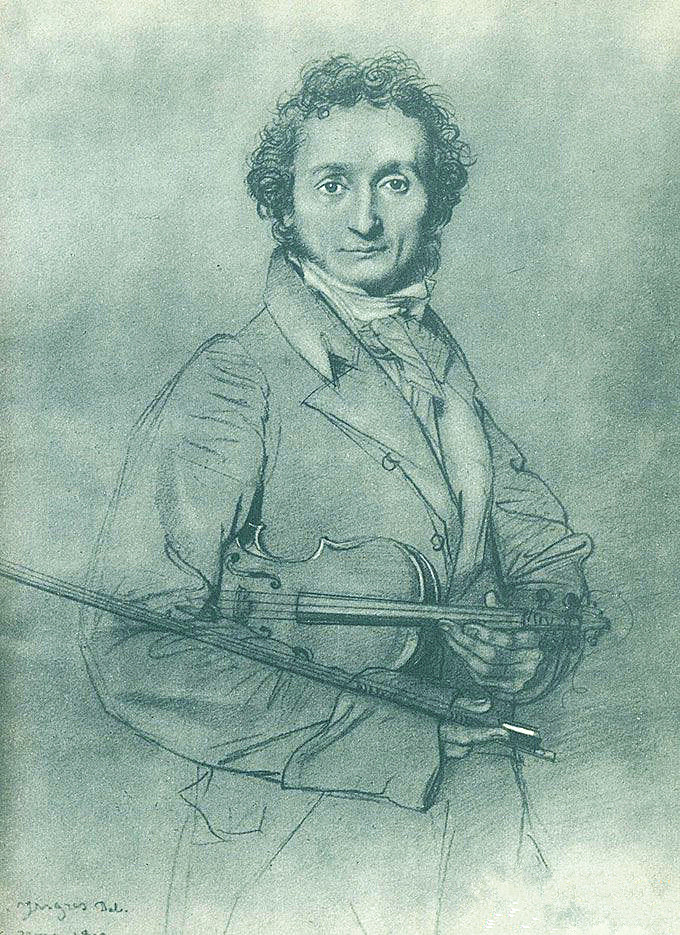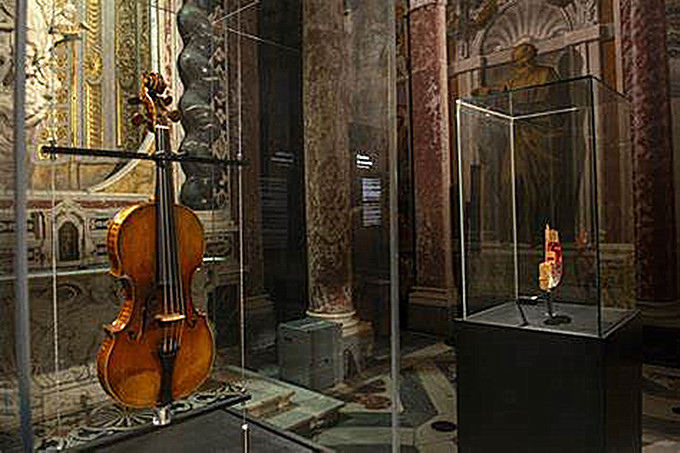| |
|
|
|
|
|
|
|
|
|
|
| |
| |
 |
|
| |
田润德 编译文/图
2025-10-27 12:30更新 |
|
| |
|
|
|
|
| |
 |
|
|
|
| |
尼科罗·帕格尼尼(Niccolò Paganini ,1782年10月27日—1840年5月27日) |
|
|
|
| |
|
|
| |
第58届帕格尼尼小提琴比赛决赛,章奥哲演奏帕格尼尼协奏曲、柴可夫斯基协奏曲演出片段.(20251026) |
|
|
|
| |
The final of the 58th
Paganini Violin Competition, Zhang Aozhe performed excerpts from
Paganini's concerto and Tchaikovsky's concerto. |
|
|
|
| |
|
|
|
|
| |
音乐历史上的今天
1782年10月27日,尼科洛·帕格尼尼在热那亚出生。“我五岁半时,我的父亲、一个商人,教我弹曼陀铃。差不多在那个时候,救世主出现在我母亲的梦中,允许她许一个愿,于是她便请求让她的儿子成为一个伟大的小提琴家;她的愿望实现了。”(1828年2月28日凌晨3点听写的《自传》)
尼科罗·帕格尼尼(Niccolò Paganini
,1782年10月27日—1840年5月27日),意大利小提琴、吉他演奏家、作曲家、早期浪漫乐派音乐家,是历史上最著名的小提琴大师之一,
这位处于古典主义晚期和浪漫主义早期的小提琴大师,对小提琴演奏技术进行了大胆探索。
帕格尼尼开拓了近代小提琴的演奏技巧,成为名震欧洲的最著名小提琴家。他的演奏技巧高超,表情丰富,情绪激奋,如痴如醉,引人入迷。他常在音乐会上才华横溢地即兴演奏。为了炫耀技巧,他甚至故意弄断小提琴上的一两根弦,然后在剩下的琴弦上继续演奏。他的作品和演奏技巧几乎慑服了欧洲所有的艺术家,如文学大师司汤达、巴尔扎克、梅涅、大仲马,音乐大师肖邦、舒曼、李斯特等,听过他的演奏无不为之激动不已。他对肖邦、柏辽兹尤其是李斯特等人的音乐创作,产生了强烈的影响。
当年的文学家海涅在一篇文章里是这样介绍帕格尼尼的音乐会:
当帕格尼尼重新开始演奏时,我的眼前黯淡下来。曲调没有变幻出明快的形式和明亮的色彩;大师形象被昏暗的阴影所笼罩,他的音乐自黑暗中发出极尖锐的悲叹声。间或,悬在他头顶的小灯以微弱的灯光投向他;只是此时,我才看得见他那了无血色的面容,但他脸上的青春并没有逝去。他的外衣十分抢眼,析出两种颜色,半是黄色,半是红色。他的脚上拴着沉重的镣铐。他的身后隐隐约约闪现出一张脸,其容貌有几分像滑稽的山羊,双手裸露长毛,看起来也像山羊蹄子;时而,我发现这双手伸向帕格尼尼手中的提琴,乐于助人似地拨弄琴弦;时而,他也把持着帕格尼尼拉弓的那只手,使小提琴涌出的越来越痛苦悲伤的曲调声中,伴入了咩咩的赞许笑声。这曲调宛如堕落天使们的歌声,她们因为拥抱了大地的女儿而被逐出天国,带着瘦削绯红的脸蛋隆降下人间尘世。这是来自无底深渊的曲调,没有安慰,没有希冀。如果天上圣人听见这种曲调,上帝的赞美也会黯然失色,他们将羞愧得无地自容!每当那须臾不肯离舍的、咩咩的山羊笑声伴入提琴曲的悲伤旋律时,我偶尔瞥见背景中也有一群小个子丑陋女人,她们狡黠、诙谐地点着头,面带幸灾乐祸的表情,指手画脚地大肆嘲讽。未几,提琴声中逸出了恐惧的音调,一声惊叹,一场抽噎,这声音在人世间从来没有听到过,或许在人世间永远也不会再听到,除非是在世界末日的约撒法特山谷,当法庭的巨大长号奏响,赤身裸体的尸首们从坟墓中爬出来,期待着他们的命运之时……然而,痛苦的琴师突然运出了极为绝望的一弓,以至于脚镣铿锵断裂,那些阴森森的助手连同讥讽魔鬼统统销声匿迹。
他到处举行独奏音乐会,绝技超群的名声迅速传遍意大利。摆脱了父亲严厉控制的帕格尼尼尽情享受着自由的乐趣。他喜欢追逐漂亮的女性,喜欢大手巴地花钱,喜欢赌博,有时打起牌来会手巴靠演出挣来的一笔数目惊人的巨款输得精光,但却满不在乎!他天生一副古怪、丑陋而又精致的长相,而他拉琴的技巧又那么神妙莫测,再加上他那一连串的风流艳事与放纵的生活方式,于是各种关于他的离奇的故事很快便传播开来。这些奇谈怪论只能使他更加出名!
1839年10月,大师的身体终于彻底垮了下来,人们把他护送到法国南部疗养圣地尼斯。
1840年5月27日,帕格尼尼濒临死亡。天主教会打算利用这最后的机会拉他回头,他们派了一名神父前去为大师举行临终圣餐与忏悔。帕格尼尼不仅坚决拒绝了这一套仪式,而且与天主教开了个最后的玩笑。神父吓得破门而逃,帕格尼尼开心得放声大笑!因笑得太厉害而引起连连咳嗽,哽咽住气管,一命呜呼。
奇特的天才即使在死后也继续经历着奇特的遭遇。由于他生前与宗教势不两立,天主教会下令禁止帕格尼尼的尸体入土埋葬。人们只好将他的遗体涂上防腐剂,送到麻风病院里存放。最后,在巨大的社会舆论压力下,法国有关当局终于批准将已经曝尸4年之久的大师遗体运回意大利下葬。1896年,人们把帕格尼尼安葬在帕尔马新公墓。
今日视频:1、第58届帕格尼尼小提琴比赛决赛,章奥哲演奏帕格尼尼协奏曲、柴可夫斯基协奏曲演出片段;2、
【魔鬼小提琴家帕格尼尼】-琴弦上的魔王。 |
|
|
|
| |
 |
|
| |
尼科罗·帕格尼尼(Niccolò Paganini ) |
|
|
|
| |
Today in the history of music
On October 26, 1879, Edvard Lalo's "Norwegian Rhapsody" did not
receive the same response as his "Spanish Symphony". French
composer and violinist Edvard Lalo (1823-1892) was born on
January 27, 1823, in a family of Spanish descent in Lille.
During his childhood, he had the privilege of receiving strict
training in playing string instruments from the violin teacher
at the Lille Music Academy and a local cellist who had played in
Beethoven's conducting orchestra. Therefore, his initial hobby
was primarily chamber music. Lalo's desire to pursue a career in
music was not understood by his father, and at the age of 16
(1839), he resolutely left home and went to Paris to study
composition at the music academy, but the period was not long.
Lalo's life story is rarely known, even the college archives
have incomplete records. It is only known that during his
twenties to his thirties, his main interest was still chamber
music. He wrote sonatas and salon-style songs, but they were not
successful. For a long time, he lived by teaching and playing
the violin or viola in the Armingaud-Jacquard Quartet he founded
in 1853. After ten years of creative pause, Lalo began to write
the opera "Fesco" for a competition based on Schiller's theme in
1867, but it neither won an award nor received an opportunity
for performance. Later, the author used some of the materials to
rewrite other works. Several years later, Lalo turned to
composing instrumental works, and the results were quite
different. His "Jubilee" (1872), "Spanish" Symphony (1873), and
several violin concertos, "Norwegian" Rhapsody (1881), and "G
minor Symphony" (1885-1886), etc., were all warmly welcomed by
the audience. At the same time, Lalo did not give up writing
operas. His new opera "King of Is City" began in 1875 and was
completed in 1887, a total of thirteen years. This work went
through a long and difficult period, and when it was
successfully performed and won an award in 1888, Lalo was 65
years old and not far from his death. His last unfinished opera
"Zakre Peasant Uprising" was later completed by French composer
A. Coquard (1846-1910). The enthusiasm aroused by the
Franco-Prussian War prompted some patriotic composers, including
Saint-Saëns, to form the French National Music Association in
1871, aiming to revive the French national music culture. Lalo
was a member of the association along with Frank, Guiraud
(1837-1892), Dubois (T. Dubois, 1837-1924), and Fauré, etc. Lalo
added the passionate temperament that Saint-Saëns lacked to
French music, as well as the rhythmic vitality combined with
refinement and skill, and the inherent characteristics of the
French people in expressing emotions, such as quick and clear
reactions. If French composer David (F. C. David, 1810-1876)
introduced the oriental flavor into the French concert hall in
his symphonic anthem "Desert" in 1844, before Liszt began to
create his series of symphonic poems, then Lalo was more
confident in developing this exotic taste and making it one of
the most prominent features of French music later. His symphony
"Spain", the rhapsody "Norway", the fantasy "Nawie", the
concerto "Russia", and the fragments of the ballet "Namona", all
exhibit a picturesque tendency - this is further emphasized in
many different works by French composers such as Chabrier,
Debussy, Ravel, Schmidt and Roussel. Therefore, it can be said
that in terms of the application of orchestral color, Rallo was
the direct precursor of the younger generation in the French
music circle. Rallo was quite weak in body due to intense
creative work in his later years. At the time of writing the
ballet "Namona", he had suffered from paralysis due to lack of
physical strength. On April 22, 1882, he passed away in Paris
due to a sudden heart attack.
Today's video: 1. Augustin Hardlich performs Rallo's "Symphony
of Spain"; 2. Edgar Moreau performs the cello concerto by
Édouard Rallo (1823 - 1892).
|
|
|
|
| |
 |
|
|
|
| |
尼科罗·帕格尼尼(Niccolò
Paganini ) |
|
|
|
| |
1782年10月27日,意大利小提琴家、作曲家尼科罗·帕格尼尼诞生。这位处于古典主义晚期和浪漫主义早期的小提琴大师,对小提琴演奏技术进行了大胆探索。 |
|
|
|
| |
|
|
|
|
| |
 |
|
| |
帕格尼尼笔迹 |
|
|
|
| |
Paganini's
handwriting |
|
|
|
| |
 |
|
| |
帕格尼尼乐谱手稿 |
|
|
|
| |
Paganini's sheet music manuscript |
|
|
|
| |
 |
|
| |
尼科罗·帕格尼尼(Niccolò
Paganini )演出海报。 |
|
|
|
| |
爱德华·拉罗(Edouard
Lalo)唱片封面 |
|
|
|
| |
 |
|
|
|
| |
让·奥古斯特·多米尼克·安格尔(Jean Auguste
Dominique Ingres,1780-1867)
的一幅流传非常广的作品《帕格尼尼》 |
|
|
|
| |
安格尔和德拉克洛瓦是帕格尼尼同时代的画家,他们一个是古典主义的忠实信徒,一个是浪漫主义的追随者,他们秉持的是水火不相容的两种美学观点。
安格尔曾经在罗马为帕格尼尼画过像,而且对他的演奏,特别是演奏古典大师们的作品十分钦佩。迪瓦尔告诉我们,幕布打开时,舞台上是空的,没有布景和道具。然后一位瘦高、身穿黑色服装,简直像魔鬼一样的人走上了舞台。大厅里鸦雀无声,令人有些毛骨悚然。然而从他演奏第一个音起,就把听众给抓住了。安格尔表现出颇为佩服的神态。但是当帕格尼尼突然尽情地施展所谓的“产生这样奇怪的演奏学派的绝技”的时候,安格尔脸上露出了愤怒的表情。听众越来越高兴,他却变得更加愤怒了。最后他终于站起来高声喊道:“他不是帕格尼尼!他是个异教徒,是个叛徒!”忠于古典传统的安格尔感觉自己受到了表现主义的亵渎。这位深深扎根于艺术纯净血统之中,主张在艺术中运用理智的安格尔,在帕格尼尼的身上看到了自己理想的对立面。但是在听众席中还有另外一位反应完全不同的画家,那就是安格尔最大的敌人,浪漫主义的德拉克洛瓦。德拉克洛瓦完全被帕袼尼尼征服了。在他的《回忆录》中他这样写道:“在我们面前的是一位创造家!是位真正的艺术家!” |
|
|
|
| |
Ingres had painted
paganini in Rome and admired his playing, especially of the old
masters.Duval told us that when the curtain opened, the stage was empty,
with no set or props.Then a tall, thin man dressed in black, almost like
a devil, walked onto the stage.The silence in the hall was eerie.From
the first note, however, he caught the audience.Angel looked rather
impressed.But when paganini suddenly indulged in what he called "the
stunt that produced such a strange school of playing", angel's face
broke into an angry expression.As the audience grew happier, he grew
angrier.At last he rose and shouted: "he is not paganini!He's a heretic,
a traitor! 'True to the classical tradition, angel felt himself profaned
by expressionism.Deeply rooted in the pure blood of art and advocating
the use of reason in art, angel saw the opposite of his ideal in
paganini.But there was another painter in the audience who had a
different reaction, and that was Angle's greatest enemy, the romantic
delacroix.Delacroix was completely conquered by paganini.In his memoirs
he wrote: "before us is a creator!A real artist!" |
|
|
|
| |
 |
|
|
|
| |
尼科罗·帕格尼尼(Niccolò
Paganini )唱片封面 |
|
|
|
| |
 |
|
|
|
| |
帕格尼尼的出生地。 |
|
|
|
| |
The Birthplace of Paganini. |
|
|
|
| |
 |
|
| |
帕格尼尼去世的那所房子。 |
|
|
|
| |
The house where
Paganini died. |
|
|
|
| |
 |
|
| |
被称为“Il
Cannone”(大炮)的瓜纳里乌斯小提琴已经从尼科洛·帕格尼尼的家乡热那亚送到格勒诺布尔的欧洲同步辐射设施进行x射线显微分析。
其目的是记录其结构的每一个粒子,并在它们变得严重之前发现可能的缺陷。这把小提琴可以追溯到1743年。
如今,热那亚帕格尼尼国际小提琴比赛的优胜者都在演奏这首曲子。
帕格尼尼死于1840年。 |
|
|
|
| |
 |
|
| |
The Guarnerius violin known as "Il Cannone" (The Cannon) has
been transported from the hometown of Niccolò Paganini, Genoa,
to the European Synchrotron Radiation Facility in Grenoble for
X-ray microscopic analysis. The aim is to record every particle
of its structure and detect possible defects before they become
serious. This violin dates back to 1743. Nowadays, the winners
of the Genoa Paganini International Violin Competition perform
this piece. Paganini died in 1840. |
|
|
|
| |
|
|
|
|
| |
 |
|
|
|
| |
章奥哲(Aozhe Zhang) |
|
|
|
| |
章奥哲(Aozhe Zhang),2008年出生于安徽合肥,中国青年小提琴演奏家,现为上海音乐学院附中高三学生,师从何弦教授。4岁随刘新华学习小提琴,9岁转入何弦门下,2018年以专业第一名考入上海音乐学院附小,2021年免试直升附中
。14岁成功演绎帕格尼尼全套24首随想曲并在贺绿汀音乐厅举办独奏音乐会
[7-8]。2023年获得第十四届中国音乐金钟奖,成为该赛事年龄最小获奖者
。2024年获第43届意大利鲁道夫・里匹策国际小提琴比赛第一名及两项特别奖
[5]。2025年接连斩获瑞士蒂博尔・瓦尔加国际小提琴比赛第一名及青年评委会奖、第九届日本仙台国际小提琴比赛第三名(第一名空缺)
,同年10月夺得第58届帕格尼尼国际小提琴比赛金奖及最佳帕格尼尼协奏曲演奏奖,成为继吕思清、黄滨、黄蒙拉、宁峰后第五位获此殊荣的中国演奏家
。曾与上海爱乐乐团、广州交响乐团、昆明聂耳交响乐团、安徽乐团等合作演出,两度登上上海之春国际音乐节舞台。 |
|
|
|
| |
 |
|
| |
章奥哲(Aozhe Zhang) |
|
|
|
| |
 |
|
| |
章奥哲(Aozhe Zhang) |
|
|
|
| |
Aozhe
Zhang was born in Hefei, Anhui Province in 2008. He is a young
Chinese violinist. Currently, he is a senior high school student
at the Shanghai Conservatory of Music High School, under the
guidance of Professor He Xian. He began learning the violin at
the age of 4 under Liu Xinhua and later joined Professor He
Xian's class at the age of 9. In 2018, he was admitted to the
Shanghai Conservatory of Music Primary School with the top score
in the major. In 2021, he was directly admitted to the Shanghai
Conservatory of Music High School without taking the entrance
exam. At the age of 14, he successfully performed the entire 24
Caprices by Paganini and held a solo concert at the He Zengdi
Concert Hall [7-8]. In 2023, he won the 14th China Golden Bell
Music Award, becoming the youngest winner in this competition.
In 2024, he won the first prize and two special awards at the
43rd Italian Rudolf Rippel International Violin Competition [5].
In 2025, he successively won the first prize and the Young Jury
Award at the Thibol Vargha International Violin Competition in
Switzerland, and the third place at the 9th Sendai International
Violin Competition (the first place was vacant). In October of
the same year, he won the gold medal and the Best Paganini
Concerto Performance Award at the 58th Paganini International
Violin Competition, becoming the fifth Chinese violinist to
receive this honor after Lu Siqing, Huang Bin, Huang Mengla, and
Ning Feng. He has performed with the Shanghai Philharmonic
Orchestra, Guangzhou Symphony Orchestra, Kunming Nie'er Symphony
Orchestra, Anhui Orchestra, etc., and has twice performed on the
stage of the Shanghai Spring International Music Festival. |
|
|
|
| |
|
|
|
|
| |
Today in
Music History:
On
October 27, 1782, Niccolò Paganini was born in Genoa. "When I
was five and a half years old, my father, a merchant, taught me
to play the mandolin. Around that time, the Savior appeared in
my mother's dream and allowed her to make a wish. So she asked
that her son become a great violinist; her wish was fulfilled."
(Transcribed from the autobiography at 3 a.m. on February 28,
1828)
Niccolò
Paganini (1782 - 1840), an Italian violinist, guitarist,
composer, and early Romantic musician, was one of the most
famous violin masters in history. This violinist, who was at the
end of the Classical period and the beginning of the Romantic
period, boldly explored the playing techniques of the violin.
Paganini expanded the playing techniques of the modern violin
and became the most famous violinist in Europe. His playing
skills were superb, his expressions were rich, his emotions were
intense, and he was entrancing and captivating. He often
performed impromptu masterfully at concerts. To show off his
skills, he even deliberately broke one or two strings on the
violin, and then continued playing on the remaining strings. His
works and playing techniques almost overwhelmed all the artists
in Europe, such as the literary masters Stendhal, Balzac, Méne,
and Dumas, the music masters Chopin, Schumann, and Liszt, etc.
Those who heard his performance were all deeply moved. He had a
strong influence on the musical creations of Chopin, Berlioz,
and especially Liszt. The literary figure Heinrich Heine
described Paganini's concerts in an article as follows: When
Paganini resumed playing, my vision dimmed. The melody did not
transform into a lively form or bright colors; the master's
image was shrouded in dark shadows, and his music emitted a
sharp lamentation from the darkness. Occasionally, a faint light
shone on him from above; only then could I see his pale face,
but his youth had not faded. His coat was very eye-catching,
separating into two colors, half yellow, half red. His feet were
tied with heavy shackles. Behind him, faintly appeared a face,
somewhat like a comical goat, with long hair on his hands,
looking like goat hooves; sometimes, I noticed his hands
reaching towards the violin in his hand, helping-like, plucking
the strings; sometimes, he held the hand that was pulling the
bow, adding a咩咩-like approving laughter to the increasingly
painful and sad melody emerging from the violin. This melody was
like the singing of fallen angels, who, because they embraced
the daughter of the earth, were expelled from heaven and fell
down to the earthly realm with thin and red faces. This was a
melody from the bottomless abyss, without consolation or hope.
If the saints in heaven heard this melody, the praise of God
would lose its luster, and they would be ashamed beyond belief!
Every time the sheep-like goat laughter accompanied the sad
melody of the violin, I occasionally caught a glimpse of a group
of small and ugly women in the background, they were cunning and
humorous, nodding their heads, showing malicious expressions,
and pointing and gesticulating wildly in mockery. Soon, a
fearful tone emerged in the violin sound, an exclamation, a sob,
this sound had never been heard in the world, perhaps never
again in the world, except in the Yotzafat Valley of the Last
Days, when the huge bugle of the court sounded, naked corpses
emerged from the graves, awaiting their fate, expecting their
destiny... However, the painful musician suddenly delivered an
extremely desperate bow, so that the shackles clanged and broke,
and those sinister assistants, along with the mocking devil, all
vanished without a trace. He gave solo concerts everywhere, and
his reputation for extraordinary skills spread rapidly
throughout Italy. Freed from his father's strict control,
Paganini fully enjoyed the pleasures of freedom. He liked
chasing beautiful women, spending lavishly with his big hands,
and gambling. Sometimes he would lose all the money he earned
from performances in a single game, but he didn't care at all!
He had a strange, ugly yet exquisite appearance, and his
piano-playing skills were so mysterious and unpredictable.
Coupled with his series of romantic affairs and indulgent
lifestyle, all kinds of bizarre stories about him soon spread.
These strange tales only made him more famous! In October 1839,
the master's body finally completely collapsed. People took him
to the southern resort of Nice in France for recuperation. On
May 27, 1840, Paganini was on the verge of death. The Catholic
Church intended to use this last chance to bring him back, and
they sent a priest to perform the last communion and confession
for the master. Paganini not only firmly refused this set of
rituals, but also played a final joke on the Catholic Church.
The priest was scared and ran out of the door, while Paganini
happily laughed! Due to laughing too hard, he caused continuous
coughing, choked his windpipe, and died. The extraordinary
genius continued to experience strange encounters even after
death. Because he was at odds with religion during his lifetime,
the Catholic Church ordered that Paganini's body not be buried
in the ground. People had to apply a preservative to his body
and store it in a leprosy hospital. Finally, under the huge
pressure of public opinion, the French authorities finally
approved the transportation of the master's body, which had been
exposed to the elements for four years, back to Italy for
burial. In 1896, people buried Paganini in the new cemetery of
Parma. Today's video: 1. The 58th Paganini Violin Competition
Final, Zhang Aozhe performed excerpts from Paganini's concertos
and Tchaikovsky's concertos; 2. "The Devil Violinist Paganini" -
The King on Strings. |
|
|
|
| |
|
|
| |
【片段】【魔鬼小提琴家帕格尼尼】-琴弦上的魔王
|
|
|
|
| |
|
|
|
|
| |
未得原作者编者授权严禁转载www.mt77.com任何内容 |
|
|
|
|
|
|
|
|
|
|
|
|
|
|


